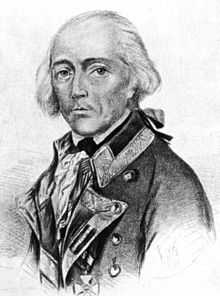Franz von Lauer
| Franz von Lauer | |
|---|---|
 Franz von Lauer | |
| Born | 11 May 1736 |
| Died |
11 September 1803 (aged 67) Krems, Austria |
| Allegiance |
|
| Service/branch | Engineers |
| Years of service | 1755-1801 |
| Rank | Feldzeugmeister |
| Battles/wars |
Seven Years War Austro-Turkish War (1787-1791) French Revolutionary Wars |
| Awards | Military Order of Maria Theresa, Knight's Cross 1789, Commander's Cross 1795 |
Franz von Lauer (11 May 1736 – 11 September 1803) began his service in the Austrian army as an engineer officer and became a general officer while fighting against Ottoman Turkey. He earned recognition as a siege specialist while fighting the armies of the First French Republic during the French Revolutionary Wars. He served as Chief of staff of the army fighting against Napoleon Bonaparte in Italy in 1796. Appointed as deputy commander of the army in southern Germany, his efforts ended in a military disaster in December 1800.
Early career
Born in 1736, Lauer studied at the Engineer Academy and joined the army of Habsburg Austria army in 1755. After being promoted to Captain during the Seven Years War, he became an expert in siege warfare.[1] He received promotion to Major in 1773, Oberstleutnant in 1779, and Oberst in 1783. During the Austro-Turkish War (1787-1791) he earned appointment to the rank of General-Major and the Knight's Cross of the Military Order of Maria Theresa for his distinguished actions at the Siege of Belgrade in 1789. He was appointed the noble rank of Freiherr in 1790.[2]
War of the First Coalition

Lauer fought on the upper Rhine River under the command of Dagobert Sigmund von Wurmser in 1793-1794. On 13 October 1793, Wurmser's army defeated the French in the First Battle of Wissembourg. Putting his engineering talents to good use, Lauer conducted a successful siege of Fort-Louis beginning the day after the battle. On 14 November, he accepted the surrender of the 4,500-man French garrison and fortress, which was then situated on an island in the Rhine River.[3] Still with Wurmser, he fought at the successful Siege of Mannheim in late 1795. For notable actions in capturing a redoubt on 30 October, he earned the Commander's Cross of the Military Order of Maria Theresa. Promotion to Feldmarschall-Leutnant followed on 4 March 1796.[2]
Lauer performed repairs to the fortifications of Mantua when the siege of that city was briefly raised in early August 1796.[4] On 19 August an order arrived from Emperor Francis II insisting that Wurmser attempt the second relief of the Siege of Mantua. The same order nominated Lauer as Wurmser's chief-of-staff. When drawing up the plan of attack, Lauer assumed that losses would prevent the French from quickly reacting to an Austrian offensive.[5] This belief proved to be a mistake when Bonaparte hurled three divisions north into the upper Adige River valley. After overwhelming Paul Davidovich's covering force at the Battle of Rovereto, the French general sent his troops marching east, then south down the Brenta River valley. Bonaparte crushed Wurmser at the Battle of Bassano on 8 September, then followed the Austrian when he raced southwest toward Mantua. Ultimately, Wurmser became trapped in Mantua with nearly 30,000 soldiers. "To his credit, Lauer thereafter proved the key man during the very stubborn defense of Mantua."[6] The fortress finally surrendered on 2 February 1797.[7]
After the War of the First Coalition Lauer became the Director-General of Engineers, a post that he held from April 1797 to February 1801.[2]
War of the Second Coalition
When hostilities broke out in 1799 in the War of the Second Coalition, Lauer was recalled to the field. Jean Moreau's victories over Pál Kray's Austrian army in May through July 1800 resulted in an armistice on 15 July. During this time, the Austrians were driven from the Rhine to the Inn River. The emperor decided to replace Kray with the 18 year old Archduke John of Austria.

Appointed Feldzeugmeister on 5 September, Lauer became John's second-in-command. The emperor expected John to remain a figurehead while Lauer made the important decisions, creating a very awkward command structure.[6] In September, Lauer pleaded for an extension of the truce and was upheld by the emperor. The old general hoped that his army could gain strength for the inevitable clash.[8]
On 12 November the armistice lapsed and war broke out again. Franz von Weyrother, Archduke John's chief-of-staff, persuaded John and Lauer to adopt an offensive strategy against the French. Because of the limitations of the Austrian army, the hard marching only succeeded in tiring out the troops for the coming battle.[9] The combination of John's inexperience, Weyrother's aggression, and Lauer's inability to restrain his colleagues proved fatal. The Austrians scored a costly victory over the French at the Battle of Ampfing on 1 December 1800. This success made the archduke and his staff reckless in their zeal to get to grips with Moreau. Lauer remained cautious but found himself unable to impose his views on the army headquarters. On 3 December, the Austrians advanced in four non-mutually supporting columns through rough terrain to open the Battle of Hohenlinden.[10] Moreau's army ambushed the Austrians and enveloped their left flank, inflicting a decisive defeat.[11] After a vigorous French pursuit, the Austrian army's morale collapsed, and the emperor was forced to sue for peace.[12]
Blamed for the disaster, Lauer retired from the army in 1801. He died in Krems, in modern-day Austria on 11 September 1803. He married Maria d'Allio and his son Joseph Lauer, born in 1769, also became a general.
Footnotes
References
Printed materials
- Arnold, James R. Marengo & Hohenlinden. Barnsley, South Yorkshire, UK: Pen & Sword, 2005. ISBN 1-84415-279-0
- Boycott-Brown, Martin. The Road to Rivoli. London: Cassell & Co., 2001. ISBN 0-304-35305-1
- Chandler, David. The Campaigns of Napoleon. New York: Macmillan, 1966.
- Smith, Digby. The Napoleonic Wars Data Book. London: Greenhill, 1998. ISBN 1-85367-276-9
External references
|